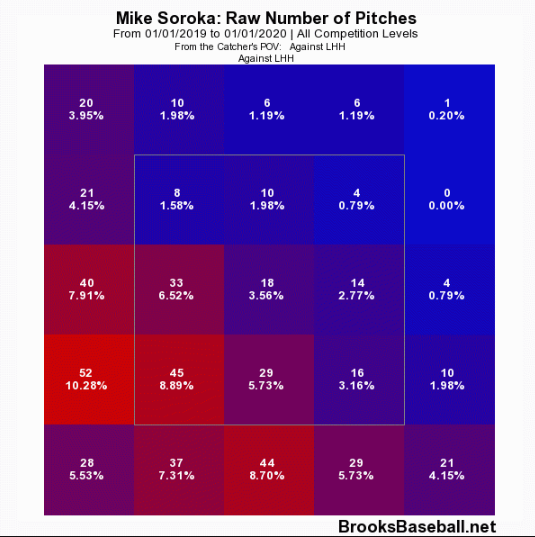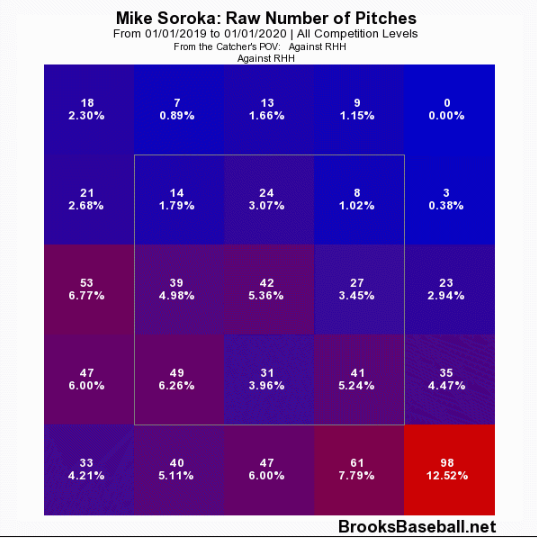When it comes to young pitchers, there is seldom any degree of confidence in projecting their futures. TNSTAAPP (There’s No Such Thing As A Pitching Prospect) is a phrase that has become a staple of my mindset over the years. A healthy dose of cynicism has been born from seasons of watching young arms touted as the next big thing, either flame out entirely or fail to ever reach their lofty expectations even when they do make it. Factoring in the added unpredictability with long-term pitcher health because of how much more frequently they get injured than hitters, it’s hard to ever truly get too geeked up on the idea of “can’t-miss” pitching prospect. However, it’s also important to be proactive when a young arm with the requisite potential begins to demonstrate that they can succeed in sustainable ways. One guy that it’s time to start viewing in this light is the Atlanta Braves‘ 21-year-old Mike Soroka. The right-hander has plenty of pedigree, he was the 28th pick in the 2015 MLB draft and entered 2019 as MLB.com’s No. 24 prospect following an impressive stretch of five starts late in 2018 during his first taste of the big leagues. Soroka doesn’t light up the radar gun, topping out around 93-94 mph on his fastball, and he isn’t a strikeout wizard, but he does a number of other things below the surface well enough to compensate.
How Does He Do It?
Soroka is an excellent example of how a pitcher doesn’t have to have overpowering raw stuff to succeed, and his ability to locate with precise control and limit hard contact and fly balls is almost a throwback in this era of flamethrowing strikeout savants who rush the ball up high in the zone. Soroka ranks right around the middle of the pack in fastball velocity and fastball spin rate per Baseball Savant, but his strikeout rate leaves him in the bottom third of the league among starters at 31st percentile. However, while he has just 73 strikeouts over his first 89.1 innings, his swinging strike rate (SwStr%) of 10.4% is plenty respectable and places him 44th among qualified starters, and suggests that he may even be able to increase the strikeout rate over time.
Soroka’s path to success isn’t based on his outcomes when the batter swings and misses his offerings entirely, but rather in what happens when his opponents do manage to make contact. Soroka is one of the most challenging arms to square up, and that shows in his having a Hard Hit rate in the 70th percentile as well as an expected slugging percentage in the 84th percentile. Even more impressive, his exit velocity allowed is in the 86th percentile. Soroka is a nightmare to try to do damage against as a batter, and all of these underlying numbers set up the most impressive of all: Among starting pitchers with a minimum of 140 batted ball events, Soroka ranks first in minimizing the percentage of barreled balls allowed per plate appearance (Brls/PA %). A barreled ball is one whose comparable hit types (in terms of exit velocity and launch angle) have led to a minimum .500 batting average and 1.500 slugging percentage since Statcast was implemented across the major leagues in 2015. Barrels are one of the most valued forms of currency for a batter in 2019, as shifts and advanced positioning for defenses has led to the suppression of hits, and Soroka is the single most stingy starting pitcher in allowing them. He has been barreled up in only 2.2% of times the ball is put in play and a grand total of… eight times.
When reviewing Brooks Baseball’s heat map for Soroka, it is pretty clear what he’s trying to do when he starts out an at-bat. On 0-0 counts so far this season, he lives in the bottom half of the zone, and even a little outside of it. with the heaviest zones hit being the down-and-away corner to both right and left-handed hitters. Instead of attempting to generate a swing and miss with a pitch high in the zone, Soroka makes a concerted effort to stay lower, seeking an opportunity to get a batter to put the ball in play, likely weakly on the ground. His locations change slightly when he gets to two strikes, but he remains down in the zone primarily. This helps explain why he doesn’t have gaudy strikeout totals, since there has been such emphasis in recent years for hitters to work on hitting lower pitches, and hitters are better at making contact on them, even if not necessarily the barreled contact that they had intended to make.


Analyzing Soroka’s Arsenal
When looking at Soroka’s arsenal, he’s got a variety of pitches in his toolbox, including variations of a fastball/sinker, a changeup, and a slider. Fangraphs’ pitch valuations view Soroka’s changeup as a passable pitch at -0.2wCH, but rank his slider well at 5.3wSL, and the combination of his four-seam fastball and sinker earned 15.4wFB, with their combination of value being attributed to the fact that they are within one mph of each other on average. Soroka’s pitch mix and sequencing are more impressive than the sum of his total pitches, and his incredulous first half demonstrates that summation. It would be seemingly easy to project regression from the major forecasting systems, but even with regression, all of ZIPS, Steamer, and Derek Carty’s THE BAT project him to pitch to an ERA in the second half between 3.38-4.06. None of them project him to pitch to a FIP any higher than 3.96 either, and this is from projection systems that are famously conservative. These systems all think he is going to either be strong, or at least keep treading water, and that’s without factoring in the idea that a player who is only 21 years old may find another step or two forward to take as he continues making adjustments.
Watching some tape on Soroka’s first half, it is easy to see how he is successful keeping batters off-balance. Take a look at some of Soroka’s diverse arsenal in action:
This changeup’s movement has Brandon Belt’s head (and body) spinning!
https://gfycat.com/aridsneakyflycatcher
This slider completely fools Dominic Smith and isn’t even in the strike zone by the time he swings.
https://gfycat.com/discreteslimyangelwingmussel
But the most demonstrative clip is this one. Here is Soroka in a spot with a runner on, drawing a ground ball on an 0-1 pitch to Mac Williamson, that he then successfully fields himself for an inning-ending double play. There is so much to like about this.
https://gfycat.com/leafyexemplaryafricanfisheagle
Soroka does a ton of little things well here. He’s in the eighth inning of the game with a pitch count approaching 100, but still executes phenomenally to get the weak ground ball with a runner on base, and then again to make an accurate throw to second. It’s a tough pitch in the first place, but the calmness needed to field it and set his feet to accurately start the double play is awesome to watch. In a box score, Soroka would have been fine if he had deflected the ball and created an infield hit, and he would have also been fine if he had thrown off the mark to second and made it impossible to get both outs. In fact, even if he had thrown the ball away entirely, he wouldn’t have hurt his ERA since it would have been scored as his own error—something that happens with far too much regularity when a pitcher has to throw to a base. But Soroka manages to get it done, because he does many little things well. It’s no coincidence that Soroka made a strong play there, as he is a strong fielder at his position. Soroka boasts a perfect fielding percentage on the season, as he is 18 for 18 in making sure an out is recorded when he gets a chance. All three of these clips support what Brooks Baseball explained earlier too, that Soroka lives down in and just below the strike zone.
Altogether, this is a pitcher with multiple above-average pitches, who is able to field his own position well, and who is able to limit his opponents’ hard contact at an elite level. With all of the information presented, it begins to come more easily into focus just why Mike Soroka has been so good in the first half, despite middling strikeout and walk numbers, and why he has already been named to the All-Star Game so early in his career. It’s likely that this is just the first of many times that he’ll receive that honor in what appears to be a very promising career.
(Photo by Rich von Biberstein/Icon Sportswire)

How much regression should we expect from Soroka this season? How far down d0 you expect he’ll drop in the rankings?
Hi James, good question. I think it is a different conversation in dynasty/keeper since he’s so young, but for ROS-only, I think Soroka probably pitches about 5-10% under what the projection systems say. I’d say he sees a modest tick up in ERA, but think he’s more around 3.30-3.80 in that area since he profiles like a guy who can sustainably outperform a little. Add in a WHIP probably around 1.15-1.20 depending on BABIP luck, and strikeout numbers around league-average. He’s got the strong Braves’ offense behind him, so I like his chances at wins and probably would slot him in around 30th or so the rest of the way. He doesn’t figure to be on any kind of innings limit either which is huge for a young arm.
Thanks for reading!
Hey Nick,
Going forward, what kind of ballpark ERA/WHIP projection would you give Soroka? Do you see anything in his profile that could lead to main gains in K’s or anywhere else?
Thanks for asking Jonny, it’s definitely going to be interesting. If I were to set the over/under, I’d have his ERA/WHIP at 3.60/1.20 which is closer to his peripherals than his first half numbers, but still plenty playable, and I think the strikeouts question is one with a lot of variables. 21 year old arms take non-linear steps forward (or back) pretty often, but I think Soroka’s command and arsenal would allow him to increase his K/9 closer to right around one per inning if he wanted to do so. I’d conservatively say though that it’ll probably stay a little under that figure just because he knows he can be successful going deeper in games by generating weaker contact on pitches in the zone. It’s worked pretty well for him so far, after all.
That’s weird, everything I’ve read mentions a likely innings limit for Soroka this year. I even traded him based on that assumption. Perhaps I have erred.
Thanks for reading Jaybird! It’s possible I suppose, since he only got around 55 innings last year, but since Soroka had 153 and 143 innings respectively in 2016 and 2017, I don’t think the Braves are going to be especially strict in limiting him. If they do, I think it’s more likely that he get skipped once or twice or has a couple starts pushed back a day or two. I guess we shall see!